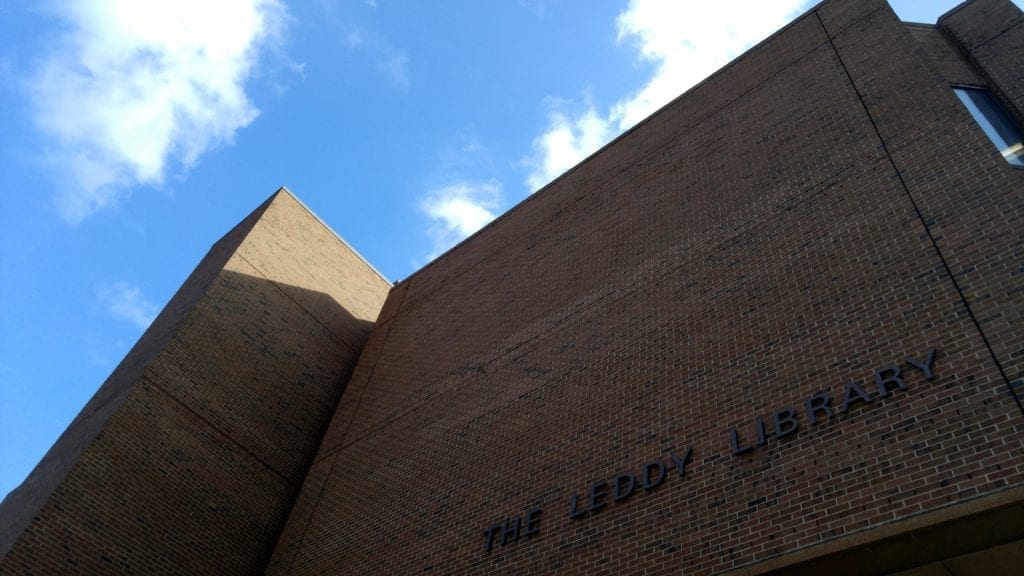When I first started the Library Nexus blog series, the focus was on what I could learn from the most traditional deliverable of a library; books. The majority of my library exploration was done without contact with other humans, just the books and me. Quiet strolls along darkened aisles that sequentially illuminate as I passed through. Delicate page-flipping of aged government reports as I sat by myself in a cubicle. But then, my perception of libraries is that they are dwellings of solitude and incessantly enforced deafening silence. Another notorious perception of libraries is that librarians are “little old ladies behind a desk” that have chosen their profession because “they like books.” Surely, these perceptions are now misconceptions by 2016. To guide me on this path of discovering the university library of the 21st century, it was time to meet the humans of the library.
I first met with Jennie Fallis. As part of her education and training to be a librarian, or to be more specific, a library information specialist (LIS), Jennie is completing a co-op placement at Leddy Library. Jennie is vibrant and approachable. Yes, she has a desk she can sit behind and knows the Dewey Decimal System but it was immediately apparent that Jennie was educated on subjects that went far beyond the scope of just books. Information policy and law, collection and access management, cultural studies, digital literacy, database design, and historical record keeping are all components of an LIS’ education (also see Charles Curran’s brilliant and witty definition of LIS).
Jennie discussed legal intricacies of copying texts, implementation of business strategies, such as marketing, to enhance patron awareness of available resources, the costly challenge of providing online access to journals to library users, and the idea of libraries as a third place. ‘Third places’ are “places in our communities where people naturally gather” that are separate from the workplace and home, and are characterized by being inclusive, free or inexpensive, offering a welcoming and comfortable atmosphere, and although not necessary, have food and drink available. Academic libraries seem to fit this description.

Jennie explained to me how libraries on campus can serve as a place between the classroom and a student’s home. How are campus libraries embracing their potential to be third places which foster greater learning and creative thinking?
Browsing the slides of a presentation by Joan Lippincott (Coalition for Networked Information) revealed libraries throughout North America are incorporating green spaces, social media initiatives, work areas with varied physical layouts, food and beverage options, and media commons (e.g., computer labs specialized for GIS, graphic design, etc.).
Public libraries off-campus are also third places. Jennie couldn’t contain her excitement for The Halifax Central Library. This stunning library has a recording studio, café, rooftop terrace, and hosts art installations, concerts, and film festivals. Jennie describes libraries as mosaics: perceived as one thing from far away but in actuality made up of many different elements aimed at engaging different demographics. Leddy is a library from far away but when you peer closer, it is made up of spaces for socialization, a place to obtain caffeine, a butterfly garden, and the information experts who support your information needs.
One such expert is Leddy science librarian Mita Williams. I asked Mita for information on libraries and librarians—my information needs were fulfilled hundredfold! I first inquired about library culture in a digital era. Like other librarians, Mita ponders this reality daily and noted how each librarian has their own “narrative” on what has changed and why. She explained that it’s normal to expect changes in user behaviour (i.e., increase in access of online versus print resources) as we want “information at the speed at which we can type”. There are data to back this notion—surveys find larger reductions in in-person library visits among graduate students and faculty from Science, Engineering and Health Sciences compared to those in Humanities/Social Sciences. Again, Mita sees these patterns as normal trajectories given that for researchers outside of engineering and natural/health sciences, the “library is their lab”.
There are many surveys of this kind and dialogues you can participate in on the implications of these surveys. Since 2011, Library 2.0 has been generating dialogue on “the future of libraries in the digital age”. Topics ranging from makerspace programs and folksonomy to intellectual freedom and visualizations of library collections, are presented through webinars and discussed through online comments and tweets via #library20.
Our conversation crossed into librarian blogs (e.g., Mita’s blog, Librarian of Things), libraries of those who have since passed, and the idea of the library as an “incubator” for art. The previous post in this series was a venture to see how scientists could tap into their artistic capacity while visiting the library. Mita lent me a copy of The Artist’s Library, a book written by co-creators of The Library as Incubator Project.
Within the first few pages I was floored. This “field guide” very thoughtfully articulates how to harness your creativity in a library. Each chapter has exercises for the reader to carry out at the library. After months of coding videos of fish swimming in boxes, my creativity cells have gone dormant and I can sense myself being pulled to Leddy’s glow of creative potential.
Each day is a new set of tasks for Jennie and Mita, from exploring the latest open access resources to leading a “Reading Challenge” that brings together students, faculty and university staff “to share a social-academic space for critical thinking and literature review.” Each day is also striving toward achieving the goal of meeting library users’ needs, which are continually evolving and so require flexibility and adaptability on the part of the librarian.
Amidst the quiet, we may not be aware of the behind the scenes hustle. There are numerous “cogs and wheels” at work to ensure the day to day operation of a library. As manager of Leddy’s circulation department Karen Pillon described, there are many individuals who keep the “heart” of a library “pumping”, no pun intended.
Learning about the complexities and depth of libraries and library science afforded me a new appreciation of the value and role of libraries to academic and public communities alike. Libraries aren’t just storage units for books. Libraries are a hub for facilitating connections between information and information-seekers, through a network of knowledge-sharing vanguards—librarians.
Next time you walk by your campus library, pop in. Getting to know the features and functions of the library will be worth your while. It may be a simple gain like finding an old read that becomes a new favourite or a new nook to doodle. Once acquainted with your library, consider connecting with your subject specialist librarian. They, along with the multitude of resources a library offers, are there to support all of your information-seeking activities (and recommend apps to track your reading). Reshape your traditional notions of what a library and librarian are. Then, share your library experiences with colleagues you know would appreciate creating their own library nexus.



